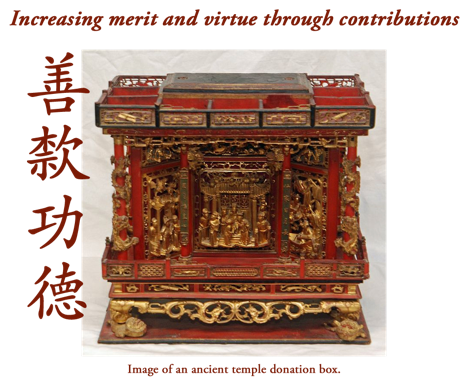The Sanctuary of Tao is a non-profit organization that depends on the generosity of our community through membership payments, programs, and donations. Your support makes a difference in helping people improve their health and well-being and to grow spiritually through engaging with these teachings.

If you like what you find through this website and want to help further this work, please consider:
—With gratitude, Sanctuary of Tao Staff
NOTICE TO CONTRIBUTORS
As of September 1, 2015, the Sanctuary of Tao officially became a 501(c)(3) non-profit educational organization. All donations are tax-deductible to the fullest extent allowed by law. We would also appreciate and recommend matching gift and estate planning programs. Sanctuary of Tao EIN: 47-4759919
Red Envelope Offerings
Over the years we’ve had many students question the purpose of using red envelopes in making offerings, gifts, and donations to others, so here’s a brief explanation of this practice.
“Red envelope” (紅包, Hong Bao) literally translates as “red package.” They are traditionally used in Chinese culture for the giving of money at New Year, usually by parents to their children. They are also used in making offerings to temples, teachers, and doctors, and with birthdays, funerals, and weddings.
The red color symbolizes good fortune and the gold lettering indicates wealth, but many of the red envelopes make use of distinct designs and Chinese characters, depending on the occasion. For marriages, the envelope usually has the symbol of double happiness (囍), which is xi (喜) doubled for the bride and groom. Some have the characters for Happy New Year (新年快樂, Xin Nian Kuai Le), or Gong Hay Fat Choy in Cantonese. The most general envelopes simply have Fu (福) for “blessing” printed on them. Red envelopes come in many other designs as well.
There are a few simple rules to follow when making use of red envelopes:
- Never give amounts using the number 4, such as $40, $44, or $444, as the character for four (四, si) is pronounced the same as the character for death (死, si), and this implies misfortune rather than good fortune.
- When receiving a red envelope from someone, do not open it in the giver’s presence. It is considered very impolite to do this.
- When passing a red envelope between two people, both should bow from the waist when giving and receiving the envelope to show humility and honor.
- Never put coins in the envelope. Always use folding money, and it’s best if the bills are new.
- The receiver should thank the giver of the envelope when receiving it and afterward write or call to express their gratitude.
- When giving to a teacher or temple, it’s best not to draw attention to the giving. In temples, there is usually a red donation box in which to deposit the envelopes. With teachers, one should leave the envelope on a table or somewhere the teacher will find it later. This manner of giving goes to the Chinese aphorism that “giving ends with the act of giving.” This way there’s no attaching to the recognition of the giving, which increases the merit of the act.
We hope this explanation makes clear the basics of using red envelopes. With the coming of the New Chinese Year, many of you may wish to use this wonderful practice of giving red envelopes to family and friends.

